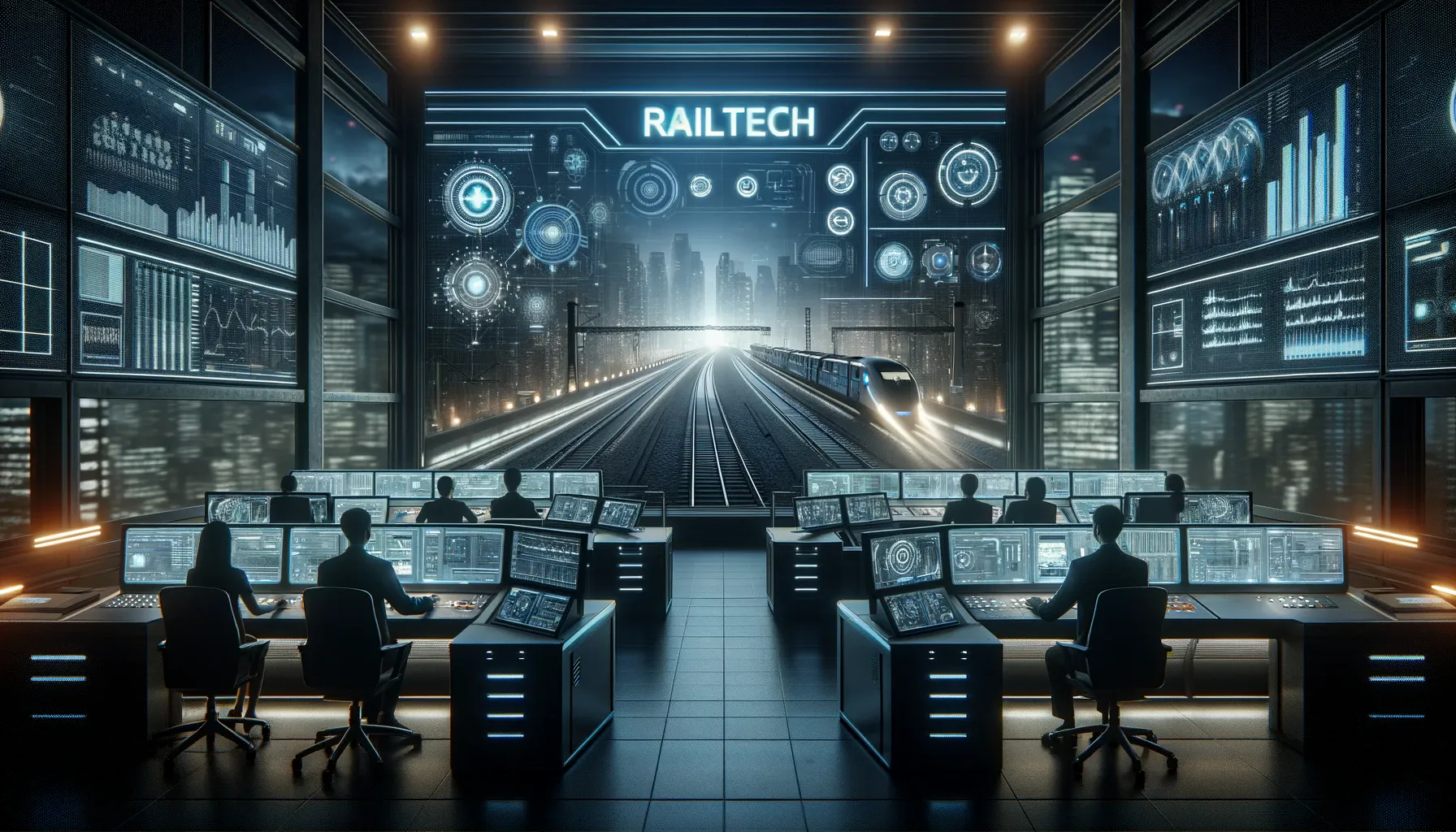Table of Contents
In recent years, the railway sector has experienced a remarkable transformation driven by the infusion of cutting-edge technologies. At the forefront of this revolution is Dynamic RailTech 2.0, an influential force propelling the industry into a new realm of efficiency and innovation, thanks to the integration of artificial intelligence (AI).
This dynamic convergence of rail tech and AI is not merely a technological upgrade but a fundamental shift that is reshaping the landscape of rail transportation. The symbiotic relationship between rail tech and AI within the framework of Dynamic RailTech 2.0 has become a defining feature of this progressive era in railway operations.
Dynamic RailTech 2.0 serves as a pivotal catalyst, bringing about unprecedented advancements in the efficiency and functionality of railway systems. By harnessing the capabilities of AI, RailTech 2.0 introduces a paradigm shift in predictive maintenance, real-time monitoring, and operational control.
This article delves into the transformative influence of Dynamic RailTech 2.0, shedding light on how the strategic integration of AI within RailTech is not only optimizing current practices but also laying the groundwork for a future where railways operate with heightened intelligence and adaptability.
The exploration of this synergy emphasizes how rail tech, fueled by AI advancements, is steering the railways toward an era characterized by enhanced performance, streamlined operations, and a more responsive and sustainable transportation network.
The Evolution of RailTech

Exploring the significance of Dynamic RailTech 2.0 necessitates a retrospective examination of rail tech’s evolution. Conventional railway systems encountered operational challenges, maintenance issues, and safety concerns. The infusion of technology, epitomized by Dynamic RailTech 2.0, emerged as a strategic response, aiming to rectify these shortcomings and forge a path toward a seamlessly connected and intelligent rail network.
This transformative integration of RailTech not only signifies a departure from traditional constraints but also heralds a future where technology augments operational efficiency, streamlines maintenance procedures, and enhances overall safety within the railway industry.
Dynamic RailTech 2.0 Unveiled
RailTech 2.0 signifies a groundbreaking advancement in railway technology, marking a significant leap forward. This integrated system capitalizes on the capabilities of AI to refine diverse facets of rail operations, ensuring heightened efficiency, minimized downtime, and bolstered safety measures. Covering a spectrum from predictive maintenance to instantaneous monitoring, RailTech 2.0 emerges as a transformative force within the industry, promising to revolutionize how railways function.
AI Advancements in Rail Operations
Predictive Maintenance
In railway operations, integrating AI, specifically within the innovative framework of RailTech 2.0, plays a pivotal role in predictive maintenance. Leveraging sophisticated algorithms, RailTech 2.0 meticulously analyzes data sourced from an array of sensors and monitoring devices. This strategic utilization of technology enables the system to forecast potential issues before they reach critical points, embodying a proactive approach that goes beyond mere problem resolution.
The result is a substantial reduction in downtime, ensuring uninterrupted rail services, while simultaneously contributing to the longevity of crucial railway assets. rail tech’s advanced predictive maintenance capabilities exemplify a transformative synergy between artificial intelligence and railway infrastructure management.
Real-time Monitoring and Control
With the incorporation of AI technology, RailTech 2.0 facilitates real-time monitoring of trains, tracks, and infrastructure within the railway network. This advanced surveillance capability ensures swift responses to anomalies, significantly bolstering both safety measures and overall operational efficiency.
The system’s capacity to control and dynamically adjust parameters in real time adds a layer of agility to railway operations, creating a more responsive and finely tuned rail tech ecosystem. This seamless integration of artificial intelligence not only enhances the proactive management of potential issues but also reinforces the adaptability of the railway system, marking a transformative step forward in the evolution of rail tech.
Positive Impact on Safety

Safety takes precedence in the railway sector, and Dynamic RailTech 2.0 tackles this imperative with a comprehensive strategy. Harnessing the capabilities of rail tech, the system conducts AI-driven risk assessments, implements automated safety protocols, and ensures real-time incident response.
The integration of RailTech 2.0 goes beyond conventional safety measures, creating an environment that prioritizes the well-being of both passengers and railway personnel. By utilizing cutting-edge technology and advanced algorithms, rail tech enhances safety protocols, making significant strides toward preventing incidents and responding swiftly to unforeseen events.
Economic and Environmental Benefits
The economic and environmental impact of Dynamic RailTech 2.0 is significant. With its AI-driven optimization capabilities, RailTech ensures substantial cost savings in both maintenance and daily operations within the railway industry. The increased efficiency facilitated by rail tech not only enhances operational performance but also contributes to a considerable reduction in the carbon footprint associated with rail transportation.
This alignment with sustainable practices and environmental goals is a crucial aspect of rail tech’s influence, showcasing its role as a transformative force in promoting eco-friendly and cost-effective solutions within the rail sector.
RailTech Empowered: AI Tools in Action
Predictive Maintenance Systems
IBM Maximo Asset Monitor employs AI and machine learning to predict equipment failures and optimize maintenance. By collecting data from sensors, analyzing historical performance, and using predictive analytics, it forecasts potential issues before they occur. This tool aims to enhance asset reliability, reduce downtime, and improve overall maintenance efficiency in railway operations.
Computer Vision in Safety Monitoring
RailSense by BlueSignals is an AI-powered computer vision system, strategically placing cameras along rail lines for advanced safety monitoring. Analyzing visual data, it swiftly detects safety hazards like trespassing and track obstructions, issuing real-time alerts to enhance railway safety measures promptly.
Natural Language Processing (NLP) for Customer Service
IBM Watson Assistant is an AI-driven NLP platform crafting chatbots and virtual assistants proficient in comprehending and responding to natural language queries. In the railway sector, it can adeptly handle passenger inquiries, furnish schedule and ticketing information, and offer assistance with general travel queries. Its seamless integration into diverse communication channels amplifies the overall customer service experience.
Automated Scheduling and Routing Systems
RailwayMaster Scheduler is an advanced software for automated train and resource scheduling. It optimizes schedules using algorithms, considering factors like track availability and demand. This tool boosts operational efficiency, minimizes delays, and optimizes resource utilization in railway networks.
Machine Learning-based Traffic Management
RailSense is a holistic machine-learning traffic management tool for railways. Using advanced algorithms, it analyzes historical and real-time data on train movements, track conditions, and external factors. The system predicts congestion, optimizes schedules, and dynamically adjusts routing, enhancing network efficiency. RailSense improves on-time performance, minimizes delays, and maximizes capacity utilization in the railway network.
Supply Chain Optimization
Blue Yonder’s Luminate Platform, formerly JDA Software, is an AI-driven supply chain management solution for railways. Leveraging machine learning algorithms, it analyzes demand, inventory, and logistics data, enabling precise predictions and real-time decisions. This platform enhances railway supply chains by optimizing demand forecasting, inventory management, and logistics planning, leading to increased efficiency and responsiveness.
Asset Tracking and Management
IBM Maximo Asset Management is an AI-powered solution for comprehensive asset tracking. It optimizes asset lifecycles, offering real-time visibility into performance. The tool aids railways in the efficient monitoring and management of infrastructure, rolling stock, and other assets. With features like work order management and predictive maintenance, it minimizes downtime, enhances reliability, and ensures compliance with industry standards in the railway sector.
Automated Inspection Systems
RailBAM (Railway Bridge Asset Management) is an automated inspection system tailored for railway infrastructure, with a focus on bridges and associated assets. Utilizing advanced technologies like LiDAR and computer vision, RailBAM automates the inspection process for railway bridges. It identifies anomalies, evaluates structural integrity, and produces detailed reports, facilitating timely and efficient maintenance. In essence, RailBAM plays a pivotal role in elevating safety standards, reducing downtime, and optimizing the overall management of railway assets.
Intelligent Video Surveillance
Video Analytics System utilizes AI algorithms to analyze surveillance camera footage, identifying real-time events like unauthorized access, suspicious behavior, and security threats. These systems bolster railway security by delivering instant alerts for timely incident responses in critical areas. Moreover, they provide insights for operational optimization and planning through the analysis of gathered video data.
Energy Consumption Optimization
EcoTrain: An AI-driven energy management system for railways, utilizing machine learning to analyze real-time data on train movement, track conditions, and energy consumption. By optimizing energy distribution based on factors like speed, acceleration, and terrain, EcoTrain enhances operational efficiency, resulting in reduced energy consumption and costs. The system promotes environmental sustainability, offering insights on regenerative braking and recommending energy-saving strategies to operators.
Crew Management Systems
CrewSense is a comprehensive tool for Railway Crew Management. This integrated workforce platform optimizes scheduling, communication, and personnel management in complex staffing environments. With features like shift scheduling, availability tracking, and real-time communication, CrewSense improves crew deployment efficiency, ensuring compliance with safety standards and regulatory requirements. The tool aims to enhance decision-making for safer and more effective railway operations.
Dynamic Pricing and Revenue Management
PROS Pricing Solutions is a leading tool for Dynamic Pricing and Revenue Management in railways. This software platform utilizes advanced algorithms and artificial intelligence to dynamically optimize pricing strategies. Specifically tailored for railways, it analyzes factors like demand patterns, historical bookings, travel times, and passenger preferences in real-time. This enables railway operators to maximize revenue, enhance seat utilization, and adapt dynamically to market conditions.

Challenges and Future Prospects
The advantages of implementing Dynamic RailTech 2.0 in the railway industry are apparent, underscoring its transformative impact. However, significant challenges loom, demanding attention in the realms of data security, integration complexities, and workforce adaptation. Overcoming these hurdles is crucial for unleashing rail tech’s full potential. As we gaze into the future, the trajectory of ongoing research and development in artificial intelligence promises to propel RailTech into new dimensions.
This continuous innovation sets the stage for a railway landscape that is not only more intelligent and interconnected but also inherently sustainable, heralding a paradigm shift in the way we perceive and operate within the rail industry.
Concluding Dynamic RailTech 2.0
The integration of AI advancements in Dynamic RailTech 2.0 signifies a crucial juncture in the ongoing evolution of railways. The infusion of cutting-edge technology through RailTech 2.0 serves as a powerful catalyst, not only effectively tackling current industry challenges but also ushering in a new era of unparalleled efficiency, safety, and sustainability.
Beyond resolving existing issues, RailTech 2.0 creates opportunities for transformative improvements. As the industry progresses, the synergy between technology and rail transport emerges as a beacon of promise, paving the way for a future characterized by heightened dynamism and substantial advancements in the realm of railways.